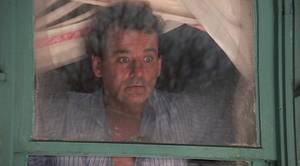“If you live each day as if it was your last, someday you’ll most certainly be right.”
–Steve Jobs
Phil Connors (Bill Murray) brings a whole new meaning to this carpe diem sentiment in Groundhog Day (1993). Self-centred TV weatherman Phil is tasked with covering the annual February 2nd Groundhog Day celebration in Punxsutawney, Pennsylvania; the groundhog, Punxsutawney Phil, is roused and scrutinized to see if he will perceive his shadow. If he does, that signals another six weeks of winter. Due to inclement weather, Phil gets delayed in Punxsutawney and falls victim to an inexplicable time loop which forces him to relive Groundhog Day: indefinitely. Each iteration of the day is marked by his clock radio striking 6:00 a.m. as he awakens in his Punxsutawney bed-and-breakfast to Sonny and Cher’s “I Got You Babe,” with the radio commentator inevitably announcing “It’s Groundhog Day!” As the only person affected by this anomaly, Phil is compelled to confront his biggest fear: himself.
Cowritten and directed by the late Harold Ramis, it would be easy to dismiss Groundhog Day as another comedy vehicle for Murray; his collaborations with Ramis, Caddyshack (1980), Stripes (1981) and Ghostbusters (1984), in particular, have helped to establish him as something of a comedic force. The film is ostensibly a high-concept comedy; it’s Murray’s nuanced performance as the egotistical Phil that anchors its philosophical core. Chris Elliot plays amicable cameraman, Larry, whilst Andie MacDowell keeps the proceedings grounded as the kind-hearted but down-to-earth Rita (Phil’s producer/love interest).

Phil (Bill Murray) first noticing he is trapped in a time warp. The negative space within this frame signifies his isolation within the Groundhog Day time loop. Groundhog Day (Columbia Pictures, 1993)
As Phil’s actions on Groundhog Day are inconsequential, he initially abuses his newfound superhuman power, engaging in a series of irresponsible and self-indulgent pursuits. This includes: repeatedly attempting to woo Rita; becoming involved in an altercation with a former school colleague after he tries to sell Phil insurance; being pursued by the police for reckless driving; and even taking the groundhog hostage.
However, as the repetitions of the day persist, the film increasingly becomes an exercise in existentialism. In one noteworthy scene, Phil tries to explain the significance of his predicament to Rita, desperately stating: “I have been stabbed, shot, poisoned, frozen, hung, electrocuted, and burned . . . and every morning I wake up without a scratch on me, not a dent in the fender. I am an immortal.” Phil begins to reexamine the meaning of his reality within the time loop, and Groundhog Day’s lighthearted tone serves to reinforce the tragic nature of his situation.
As Phil’s journey of self-discovery deepens, he starts to perform acts of goodwill; although he is destined to relive the same day indeterminately, his omnipotence allows him to acknowledge his ability to change his self-interest and, consequently, assign new meaning to his life. During a particularly significant scene, in which he tries to save an elderly homeless man, when the man is later pronounced dead, the attending nurse sincerely explains to Phil: “He was just old.” In this character-defining moment Phil realizes that, within Groundhog Day, his godlike powers are still subject to the constant nature of time. Subsequently, he contemplates the fragility of his own mortality outside of the time warp.
Throughout the course of the film, Phil traverses the emotional gauntlet, experiencing the five stages of grief: denial, anger, bargaining, depression, and acceptance. His conversion — combined with the film’s skillful hybridizing of drama, comedy, romance, and fantasy, and its subversion of narrative linearity — encourages an individualistic contextualizing of concepts as deep-seated as free will, atonement, and the meaning of life itself. Notwithstanding, the notion that resonates most profoundly within Groundhog Day is the idea that, like Phil, even in the face of great adversity, we possess the self-determination to fundamentally alter our perception of life.

Phil (Bill Murray) realizing the Groundhog Day curse has been lifted. His surprised expression hints at his reintegration into reality. Groundhog Day (Columbia Pictures, 1993)
In a study of the film’s message, comparisons can be made with It’s a Wonderful Life (1946), in which an angel is sent to Earth to show dispirited businessman George Bailey (James Stewart) an alternate reality where he never existed; and Dickens’s A Christmas Carol (1843), which centers on the rich, embittered, Ebenezer Scrooge, who is visited by the spirit of his late business partner Jacob Marley and the ghosts of Christmas Past, Present, and Yet to Come in a bid to transform him. Likewise, Phil’s liberation from the Groundhog Day curse appears to hinge on his endeavor to achieve self-redemption. The bond that he has created with Rita, the age-old trope that true love’s kiss will break the spell, seems to free him from the time loop. However, what sets Groundhog Day apart from films with a similar moral principle is that Phil’s epiphany is less dependent on supernatural guidance; his transformation ultimately comes from his own capacity to find contentment in his relatively mundane existence and, by extension, feels more genuine and altruistic.
Although it is not the first film to feature a time loop premise, Groundhog Day has left an indelible mark on contemporary culture, inspiring a number of cinematic imitations; it has arguably become as renowned as the perennial classics to which its moral is indebted. The film has also popularized the real-life Groundhog Day tradition; the phrase “This is like Groundhog Day” is now commonly used to describe a feeling of déjà vu, and also functions as a broader allegory for any type of monotonous routine. Groundhog Day will undoubtedly continue to influence popular culture, over and over and over again.
Author Biography
Luke Batten is a film and TV graduate from the UK. His approach to film criticism is focused on film’s sociological implications. His publications include: “(500) Days of Manipulation: Challenging the Romcom” (2015), Anna Kendrick: Acting Real in Tinseltown (2017), and “Groundhog Day: The Day Before Tomorrow” (2017).
Film Details
Groundhog Day (1993)
USA
Director Harold Ramis
Runtime 101 minutes








































